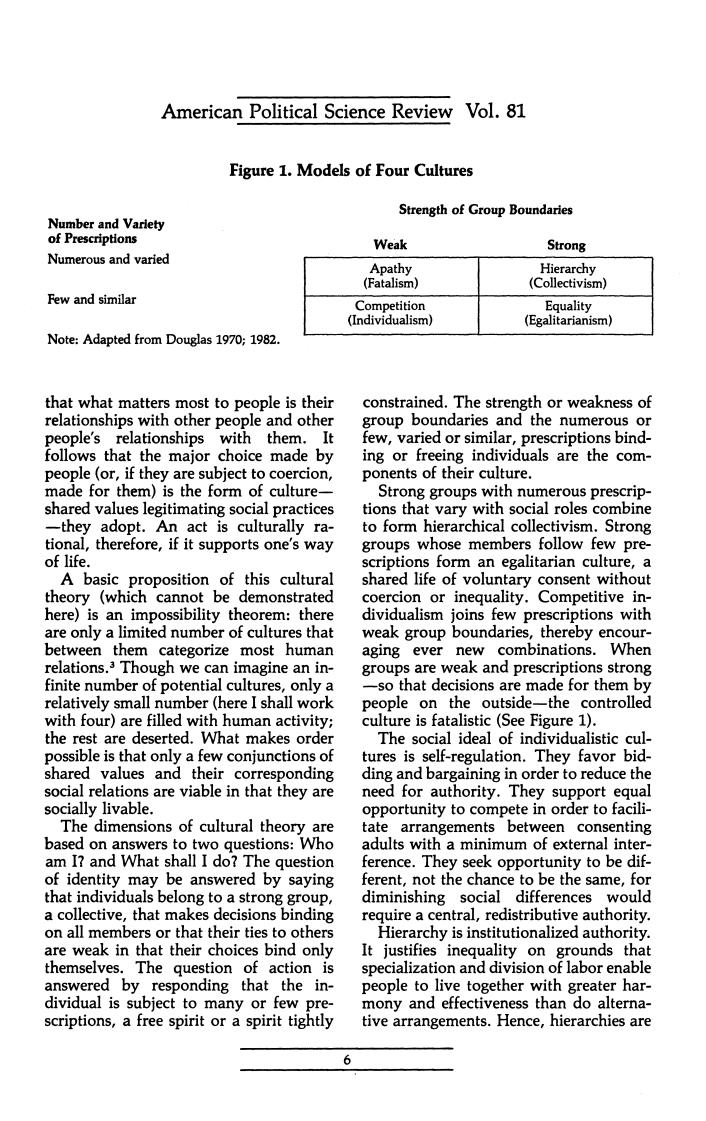正在加载图片...

American Political Science Review Vol.81 Figure 1.Models of Four Cultures Strength of Group Boundaries Number and Variety of Prescriptions Weak Strong Numerous and varied Apathy Hierarchy (Fatalism) (Collectivism) Few and similar Competition Equality (Individualism) (Egalitarianism) Note:Adapted from Douglas 1970;1982. that what matters most to people is their constrained.The strength or weakness of relationships with other people and other group boundaries and the numerous or people's relationships with them.It few,varied or similar,prescriptions bind- follows that the major choice made by ing or freeing individuals are the com- people(or,if they are subject to coercion, ponents of their culture. made for them)is the form of culture- Strong groups with numerous prescrip- shared values legitimating social practices tions that vary with social roles combine -they adopt.An act is culturally ra- to form hierarchical collectivism.Strong tional,therefore,if it supports one's way groups whose members follow few pre- of life. scriptions form an egalitarian culture,a A basic proposition of this cultural shared life of voluntary consent without theory (which cannot be demonstrated coercion or inequality.Competitive in- here)is an impossibility theorem:there dividualism joins few prescriptions with are only a limited number of cultures that weak group boundaries,thereby encour- between them categorize most human aging ever new combinations.When relations.3 Though we can imagine an in- groups are weak and prescriptions strong finite number of potential cultures,only a -so that decisions are made for them by relatively small number (here I shall work people on the outside-the controlled with four)are filled with human activity; culture is fatalistic (See Figure 1). the rest are deserted.What makes order The social ideal of individualistic cul- possible is that only a few conjunctions of tures is self-regulation.They favor bid- shared values and their corresponding ding and bargaining in order to reduce the social relations are viable in that they are need for authority.They support equal socially livable. opportunity to compete in order to facili- The dimensions of cultural theory are tate arrangements between consenting based on answers to two questions:Who adults with a minimum of external inter- am I?and What shall I do?The question ference.They seek opportunity to be dif- of identity may be answered by saying ferent,not the chance to be the same,for that individuals belong to a strong group, diminishing social differences would a collective,that makes decisions binding require a central,redistributive authority. on all members or that their ties to others Hierarchy is institutionalized authority. are weak in that their choices bind only It justifies inequality on grounds that themselves.The question of action is specialization and division of labor enable answered by responding that the in- people to live together with greater har- dividual is subject to many or few pre- mony and effectiveness than do alterna- scriptions,a free spirit or a spirit tightly tive arrangements.Hence,hierarchies are 6